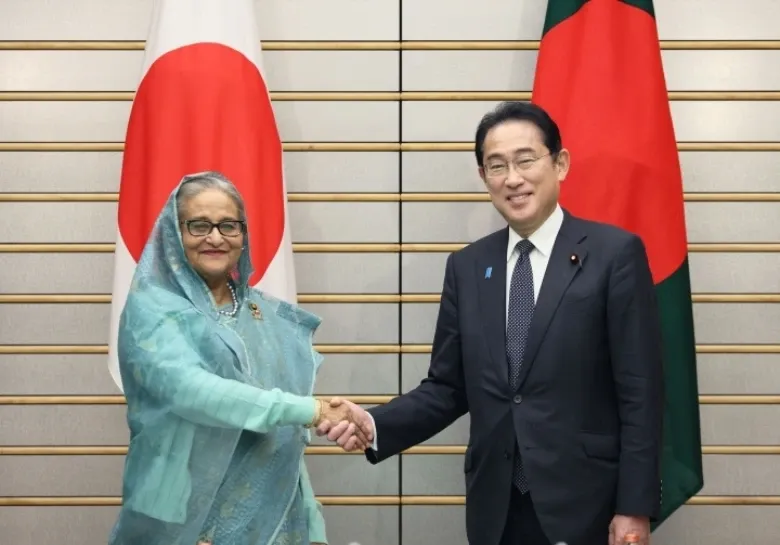-
CENTRES
Progammes & Centres
Location
All three countries have unique strengths which they can leverage by working trilaterally and together they can play a major role in shaping the future of the Indo-Pacific region

There has been growing momentum for the possibility of trilateral cooperation between India, Bangladesh, and Japan recently. This prospect has been driven by a number of factors, including the shared goals of Dhaka, New Delhi, and Tokyo of promoting a free and open Indo-Pacific region; the imperative for developing functional infrastructural links across the region; and the need to address common challenges such as terrorism, climate change, and natural disasters. At the core of the trilateral partnership lies the intent of creating an industrial hub in Bangladesh and realising the potential of the landlocked Northeastern Region (NER) of India which is vital for expanding multimodal connectivity in the South and Southeast Asian region. The NER area has been one of the primary areas for Japan’s involvement in infrastructure development with the objective of enabling and boosting industrialisation in the region and subsequently aiding in the establishment of functional regional industrial value chains.
The idea of a new industrial hub for the Bay of Bengal and Northeast India was floated by Japanese Prime Minister Fumio Kishida during his visit to India in March and was further discussed at a meeting in Agartala in April among the foreign ministers of the three countries. There are already a number of areas where India, Bangladesh, and Japan are cooperating and many more which are potential areas of collaboration. These include:
| Existing and Potential Areas of Trilateral Cooperation | |
| Infrastructure development: The three countries are working together on a number of infrastructure projects, such as the India-Bangladesh Friendship Pipeline and the Matarbari Deep Sea Port in Bangladesh scheduled to be operational by 2027. | Energy cooperation: India and Japan are helping Bangladesh to develop its natural gas resources. |
| Security cooperation: The three countries are cooperating on a number of security issues, such as counterterrorism and maritime security. | Trade and investment: The three countries are working to increase trade and investment between them. |
| Climate change: The three countries can work together to address the challenges of climate change. This can be done by sharing information and best practices, developing joint mitigation and adaptation strategies, and investing in clean energy technologies. | Education and skills development: India, Bangladesh, and Japan have strong educational institutions and could work together to develop a regional talent pool. This would help to attract foreign investment and boost economic growth in the region. |
| Healthcare: India, Bangladesh, and Japan have different strengths in the healthcare sector. By working together, they could develop a more comprehensive and affordable healthcare system for the region. | People-to-people ties: There are growing educational, cultural, and tourism links between the three countries. |
Among the above-mentioned areas, trilateral cooperation could be particularly beneficial in infrastructure development. India and Bangladesh face major infrastructure challenges, such as inadequate roads, railways, and ports, particularly with respect to last-mile connectivity and cross-border connectivity. Tokyo, which has a long history of providing infrastructure assistance to the South Asian region could play a key role in helping India and Bangladesh to address their infrastructure needs. The trilateral partnership for improving infrastructure could translate into the betterment of regional connectivity networks thereby positively impacting trade and other sectoral areas of cooperation such as disaster response, people-to-people links, and tourism.
India and Bangladesh face major infrastructure challenges, such as inadequate roads, railways, and ports, particularly with respect to last-mile connectivity and cross-border connectivity.
Considering the geography of eastern South Asia, the maritime domain is an important area of focus for the Delhi-Dhaka-Tokyo partnership in developing regional connectivity. Spanning across an area of almost 2.172 square km and framed by the coastal countries of India, Bangladesh, Myanmar and the island of Sri Lanka, the Bay of Bengal is the lifeblood of commerce and connectivity in the region. With a coastline of almost 720 km, Bangladesh considers the Bay to be its third neighbour, after India and Myanmar, and depends on the sea for over 90 percent of its international trade. For India, almost 95 per cent of its international trade by volume and 77 percent by value is seaborne, of which a substantial portion moves through the Bay of Bengal. Providing the landlocked Northeastern states access to the Bay via Bangladesh is, therefore, high on India’s development agenda.
Invested in rebuilding the Northeast and promoting industrial development in Bangladesh, Japan realises the value of the sea connect with the Matarbari (Bangladesh’s only deep-sea port) and Chattogram ports (Bangladesh’s main seaport) being key components. These ports are in geographic proximity to the Northeast and are thus in a position to facilitate its maritime connectivity. Thus at the April meeting between the three countries, Prime Minister Kishida stated that, “Viewing Bangladesh and other areas to the south as a single economic zone, we will promote the Bay of Bengal-Northeast India industrial value chain concept in cooperation with India and Bangladesh to foster the growth of the entire region.”
Invested in rebuilding the Northeast and promoting industrial development in Bangladesh, Japan realises the value of the sea connect with the Matarbari (Bangladesh’s only deep-sea port) and Chattogram ports (Bangladesh’s main seaport) being key components.
This explains Japan’s contribution in developing the Chattogram-Cox's Bazar highway projects through a first tranche loan of US$ 14.68 million. A deal worth 12, 814 crore Taka or US$ 11 million to finance this project along with two others has been signed on 29 March between the Japan International Cooperation Agency and the Government of Bangladesh. Once operationalised, the highway will ease congestion in the Chattogram port thus benefiting the trade flow of both India and Bangladesh. Furthermore, in the coming years it will also help keep congestion manageable, especially as the traffic flow in the city will increase with the operationalisation of the Matarbari port project in 2026. If Bangladesh decides to open the Matarbari port for India’s trade, upon its completion, it would significantly boost the trade of both countries, as well as benefit the Northeast region. Japan has agreed to provide US$ 319 million as the first tranche of loan for the development of this deep-sea port.
Trilateral cooperation, however, must not be limited to building connectivity infrastructures alone but also transcend to ensuring security in the Bay. This maritime space suffers from several trans-national security challenges; these need to be addressed collectively. India already engages bilaterally with Bangladesh in security cooperation in the Bay and with Japan through multilateral naval exercises of Milan and Malabar. Bangladesh has recently begun cooperating in the defence sector with Japan, following Prime Minister Hasina’s visit to Japan in April this year, to attend a summit meeting with Prime Minister Kishida. A key area of trilateral security cooperation in the Bay of Bengal would be disaster management. The littoral countries of the Bay are vulnerable to the threat of natural disasters, especially cyclones which compromises coastal infrastructure and maritime trade. Hence, these countries can benefit from emergency relief assistance. All three countries, especially Japan has developed advanced disaster preparedness and response techniques.
The littoral countries of the Bay are vulnerable to the threat of natural disasters, especially cyclones which compromises coastal infrastructure and maritime trade.
The three countries have unique strengths which they can leverage by working trilaterally. India has transformed into a willing, capable, and reliable middle power in the region, with a large and growing population. Tokyo trusts India as a key partner in the Indo-Pacific and New Delhi, too, has actively pursued efforts to promote regional connectivity links over the past decade. Bangladesh is a strategically located country with a young and growing workforce. And Japan is a technologically advanced country with a strong financial sector. Together, these three countries can form a constructive force for development, security, and peace in the Indo-Pacific.
While a trilateral arrangement for cooperation between India, Bangladesh, and Japan is still in its early stages, together with support from other powers in the region such as the United States, Australia, and Southeast Asian countries, the Dhaka-New Delhi-Tokyo partnership could play a major role in shaping the future of the Indo-Pacific region.
Pratnashree Basu is an Associate Fellow with the Centre for New Economic Diplomacy at the Observer Research Foundation
Sohini Bose is a Junior Fellow with the Strategic Studies Programme at the Observer Research Foundation.
The views expressed above belong to the author(s). ORF research and analyses now available on Telegram! Click here to access our curated content — blogs, longforms and interviews.

Pratnashree Basu is an Associate Fellow, Indo-Pacific at Observer Research Foundation, Kolkata, with the Strategic Studies Programme and the Centre for New Economic Diplomacy. She ...
Read More +
Sohini Bose is an Associate Fellow at Observer Research Foundation (ORF), Kolkata with the Strategic Studies Programme. Her area of research is India’s eastern maritime ...
Read More +